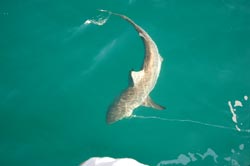|
 Photo Source: Alexa Elliot
Photo Source: Alexa Elliot |
SHARK TALES
Roughly 400 different species of sharks exist in the world today. Sharks commonly seen in Florida waters include Bonnethead, Blacktip, Great Hammerhead, Lemon, Nurse, Tiger, and Bull sharks. Unlike other fish, sharks do not have bones, instead, they posses a light cartilaginous skeleton which allows for greater flexibility. Most sharks are carnivorous animals that feed on marine invertebrates, smaller sharks, fish, and at times, birds. About 70 percent of females give birth to live pups, while the other 30 percent are egg-laying fish. Male sharks are identified by a pair of claspers or modified pelvic fins which are used for reproductive purposes.
SUPER SENSES
To be the supreme ruler of the seas requires excellent senses. Sharks are equipped with internal ears located on both sides of the head. In a world where sounds are muted, sharks hear best at frequencies below 1,000 Hertz. Picking up vibrations in the water, this species uses a lateral line system that runs along either side of the body. In addition to this, tiny dark spots on the head function as a sixth sense. Ampullae of Lorenzini are special receptor organs capable of detecting weak electro-magnetic fields. Scientists believe these receptors also serve as temperature gradients. Injured animals splashing near the surface or those hiding beneath the sand are no match for a shark’s super senses.
SKIN AND SLEEP
Reaching speeds of up to 20 mph, the Shortfin Mako is the fastest shark in the world. Sharks have specialized skin which is comprised of tiny teeth-like scales. These dermal denticles create a tough, protective exterior. To reduce friction, the scales point towards the tail. If one touches a shark and moves his or her hand towards the shark’s head, the skin feels like sandpaper. As the animal matures, the dermal denticles do not grow in size. Instead, sharks simply grow more scales.
There is much debate as to whether or not a shark is capable of sleeping. Many sharks must stay in constant motion, pushing oxygen-rich water into the mouth and gills to breathe. This process is known as ram-ventilation. But not all sharks are created equally. Some species, like Dogfish and Nurse Sharks possess an extra respiratory organ called a spiracle. Located behind the eyes, this small orifice actively pumps water into the gills and allows the shark to breathe while at rest or during feeding.
Resources for this article
have been provided by the Florida Fish & Wildlife Conservation Commission, the University of Florida Museum of Natural History Ichthyology Division and Wikipedia.
|







